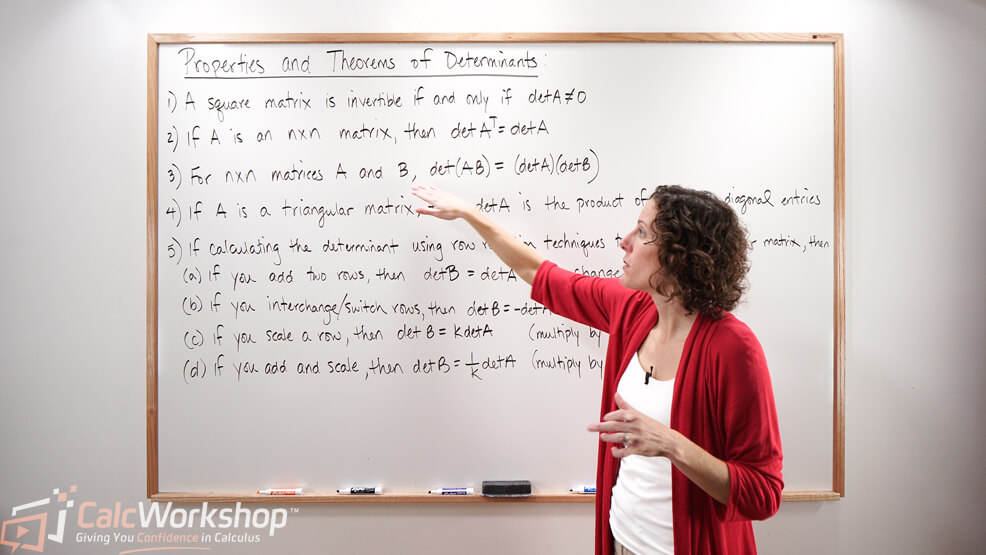Did you know that every square matrix contains a very important number called a determinant?

Jenn, Founder Calcworkshop®, 15+ Years Experience (Licensed & Certified Teacher)
A determinant is a scalar used for:
- Solving systems of linear equations
- Finding inverses
- Calculating area and volume
- Finding angles between vectors
- Vector cross products
- Change of variables in integral calculus
Calculating Determinants for 2×2 and 3×3 Matrices
So, every \(n \times n\) matrix \(\mathrm{A}\) is associated with a real number called the determinant of \(\mathrm{A}\), denoted \(\operatorname{det}(A)\) or \(|A|\).
And as we have seen in previous videos, the determinant of a \(2 \times 2\) matrix is to subtract the products of the major and minor diagonals
\begin{equation}
\operatorname{det}\left(\left[\begin{array}{ll}
\color{red}{a} & \color{blue}{b} \\
\color{blue}{c} & \color{red}{d}
\end{array}\right]\right)=\color{red}{a} \color{red}{d}-\color{blue}{b} \color{blue}{c}
\end{equation}
Additionally, in our video Matrix Operations, we learned how to extend our formula by using expansion by minors (cofactors) to evaluate the determinant of a \(3 \times 3\) or larger matrix.
But before we learn more about the importance of cofactors and determinant properties, let’s quickly review how to find the determinant using expansion by minors for a \(3 \times 3\) matrix.
Example: Expansion by Minors
Evaluate \(\left|\begin{array}{ccc}2 & -3 & -2 \\ -1 & -4 & -3 \\ -1 & 0 & 2\end{array}\right|\)
First, we must choose a row or column to expand upon and locate our “seat assignments.” Let’s select the first row and place them in their assigned (i.e., “sign”) seats.
\begin{align*}
\left|\begin{array}{ccc}
+(2) & -(-3) & +(-2) \\
-1 & -4 & -3 \\
-1 & 0 & 2
\end{array}\right|
\end{align*}
Remember, every square matrix has the following checkerboard pattern, array of signs.
\begin{align*}
\left[\begin{array}{cccc}
+ & – & + & \cdots \\
– & + & – & \\
+ & – & + & \\
\vdots & & & \ddots
\end{array}\right]
\end{align*}
Now, we expand using our selected row and signs and create three mini \(2 \times 2\) determinants by focusing on the elements not in the respective row or column as our three selected cofactors.
\begin{aligned}
& +(2)\left|\begin{array}{cc}
-4 & -3 \\
0 & 2
\end{array}\right| \\\\
& -(-3)\left|\begin{array}{cc}
-1 & -3 \\
-1 & 2
\end{array}\right| \\\\
& +(-2)\left|\begin{array}{cc}
-1 & -4 \\
-1 & 0
\end{array}\right|
\end{aligned}
Next, we apply our \(2 \times 2\) determinant formula to each, and simplify
\begin{aligned}
& +(2)\left|\begin{array}{cc}
-4 & -3 \\
0 & 2
\end{array}\right| \\\\
& -(-3)\left|\begin{array}{cc}
-1 & -3 \\
-1 & 2
\end{array}\right| \\\\
& +(-2)\left|\begin{array}{cc}
-1 & -4 \\
-1 & 0
\end{array}\right| \\\\
& +(2)[(-4)(2)-(-3)(0)] \\\\
& -(-3)[(-1)(2)-(-3)(-1)] \\\\
& +(-2)[(-1)(0)-(-4)(-1)] \\\\
& 2[-8-0]+3[-2-3]-2[0-4] \\\\
& \operatorname{det} A=-23
\end{aligned}
See, calculating the determinant is pretty straightforward. And in this lesson, we will review how to calculate a determinant for a \(2 \times 2\) matrix, \(3 \times 3\) matrix, and even a \(4 \times 4\) matrix.
Okay, so now it’s time to talk about some essential properties of determinants and see how it connects back to the Invertible Matrix Theorem.
Triangular Matrix Determinants
First, we will learn that if \(\mathrm{A}\) is a triangular matrix, then \(\operatorname{det}(\mathrm{A})\) is the product of the entries on the main diagonal of \(\mathrm{A}\).
For example, evaluate \(\left|\begin{array}{ccc}5 & 3 & -1 \\ 0 & -7 & 6 \\ 0 & 0 & 2\end{array}\right|\)
Because matrix A is an upper triangular matrix, all we have to do is multiply the entries along the main diagonal to find the determinant:
\begin{aligned}
\operatorname{det} A & =(5)(-7)(2) \\
& =-70
\end{aligned}
And this property works even for lower triangular matrices.
For instance, if
\begin{aligned}
& \left|\begin{array}{cccc}
4 & 0 & 0 & 0 \\
7 & -1 & 0 & 0 \\
2 & 6 & 3 & 0 \\
5 & -8 & 4 & -4
\end{array}\right|
\end{aligned}
then
\begin{aligned}
\operatorname{det} A & =(4)(-1)(3)(-4) \\
& =48
\end{aligned}
Gosh, calculating the determinants of triangular matrices is wickedly easy!
So, how can we use this knowledge to our advantage?
Elementary Row Operations and Determinant
By turning a matrix into a triangular matrix, using elementary row operations (i.e., REF) so that calculating the determinant is as simple as multiplying the entries of the main diagonal.
But there is a catch…when we manipulate our given matrix using row operations, we have to pay close attention to each transformation because they will impact the calculation of the determinant.
This can be a tricky concept, as some properties apply to the original matrix, A, and others apply to the transformed triangular matrix, B. So, as Kennesaw State University nicely states, it’s important to record our elementary row transformations as they affect the determinant.
How?
The key takeaways are as follows:
- A square matrix is invertible if and only if the determinant of \(A\) does not equal zero.
- For any nxn matrices \(A\) and \(B\), the \(\operatorname{det}(\mathrm{AB})=(\operatorname{det} A)(\operatorname{det} B)\)
- If \(A\) is a triangular matrix, then the \(\operatorname{det} A\) is the product of the main diagonal entries
- If \(A\) is a square matrix, then we can use row reduction techniques to create a triangular matrix to find the determinant of \(\mathrm{B}\), noting that:
- When we switch/interchange two rows, then \(\operatorname{det} B=-\operatorname{det} A\)
- When we scale a matrix, then \(\operatorname{det} B=(\mathrm{k}) \operatorname{det} \mathrm{A}\)
- When we add two rows, then \(\operatorname{det} B=\operatorname{det} A\)
Elementary Row Operations: Examples
Let’s look at a basic example to see how this works.
Suppose \(A=\left[\begin{array}{ll}1 & 6 \\ 3 & 2\end{array}\right]\). Then,
\begin{aligned}
\operatorname{det} A & =(2)(1)-(3)(6) \\
& =-16
\end{aligned}
Now, let’s see what happens when we transform matrix A by interchanging rows and see how this impacts the determinant.
\begin{aligned}
\left[\begin{array}{ll}
1 & 6 \\
3 & 2
\end{array}\right] & \underset{R_{1} \leftrightarrow R_{2}}{\sim}\left[\begin{array}{ll}
3 & 2 \\
1 & 6
\end{array}\right]
\end{aligned}
The determinant of the “new matrix,” which we call matrix B, is,
\begin{aligned}
\operatorname{det} B & =(3)(6)-(2)(1) \\
& =16
\end{aligned}
Notice that by switching two rows means we multiply the determinant of A by -1. Hence, \(\operatorname{det} B=-\operatorname{det} A \Rightarrow 16=-(-16)\)
Alright, so instead of switching rows, let’s scale a row in matrix A and see what happens.
\begin{aligned}
\left[\begin{array}{cc}
1 & 6 \\
3 & 2
\end{array}\right] & \underset{\frac{1}{3} R_{2} \leftrightarrow R_{2}}{\sim}\left[\begin{array}{cc}
1 & 6 \\
1 & 2 / 3
\end{array}\right]
\end{aligned}
The determinant of the “new matrix,” which we call matrix \(B\), is,
\begin{aligned}
\operatorname{det} B & =(1)\left(\frac{2}{3}\right)-(6)(1) \\
& =-\frac{16}{3}
\end{aligned}
Hmm. Look what happened. We multiplied the first row by \(1 / 3\) and the determinant of the new matrix was \(\left(\frac{1}{3}\right)(-16)\)
This means that when we scale a row of matrix \(\mathrm{A}\) by some number \(\mathrm{k}\), the determinant of the new matrix, B, is multiplied by that same number k. Thus, \(\operatorname{det} B=k \operatorname{det} A\).
And let’s look at our last elementary row operation, adding a multiple of one row to another, and see what happens.
\begin{align*}
\left[\begin{array}{ll}
1 & 6 \\
3 & 2
\end{array}\right] \underset{-3 R_{1}+R_{2} \leftrightarrow R_{2}}{\sim}\left[\begin{array}{cc}
1 & 6 \\
0 & -16
\end{array}\right]
\end{align*}
The determinant of matrix \(B\), our row reduced matrix is \(\operatorname{det} B=(1)(-16)-(6)(0)=-16\)
Ahh, so by doing a row replacement on A does not change the determinant. Therefore, \(\operatorname{det} B=\operatorname{det} A\).
These three properties help us explore the effects of elementary row operations on the determinant of a matrix and allow us to transform matrices into triangular matrices so we can easily calculate the determinant.
Conclusion: Multiple Methods for Calculating Determinants
And here’s what’s super cool…
We get a choice on how we calculate a determinant.
- We can use our formula for \(2 \times 2\) matrices,
- Expansion by minors (cofactors),
- Use elementary row operations to create a triangular matrix,
- Or any combination of the three as all these methods yield the same number.
What You Will Learn in this Lesson
In this lesson, you will:
- Calculate determinants
- Learn the properties of determinants
- Discover how to recognize elementary row operations and accurately describe their effects on the determinant
Get ready to see these concepts in action, and let’s dive in!
Video Tutorial w/ Full Lesson & Detailed Examples

Get access to all the courses and over 450 HD videos with your subscription
Monthly and Yearly Plans Available
Still wondering if CalcWorkshop is right for you?
Take a Tour and find out how a membership can take the struggle out of learning math.